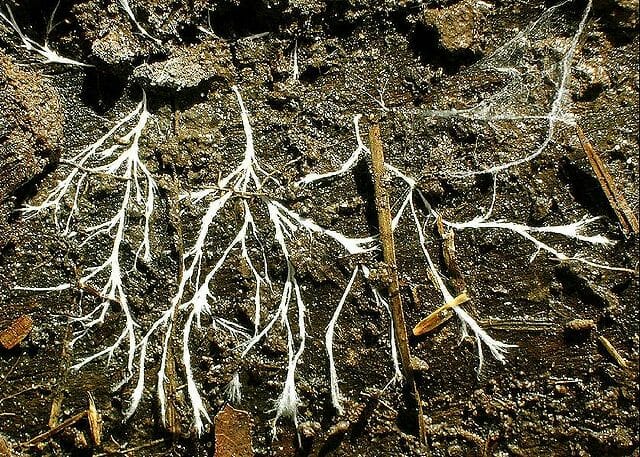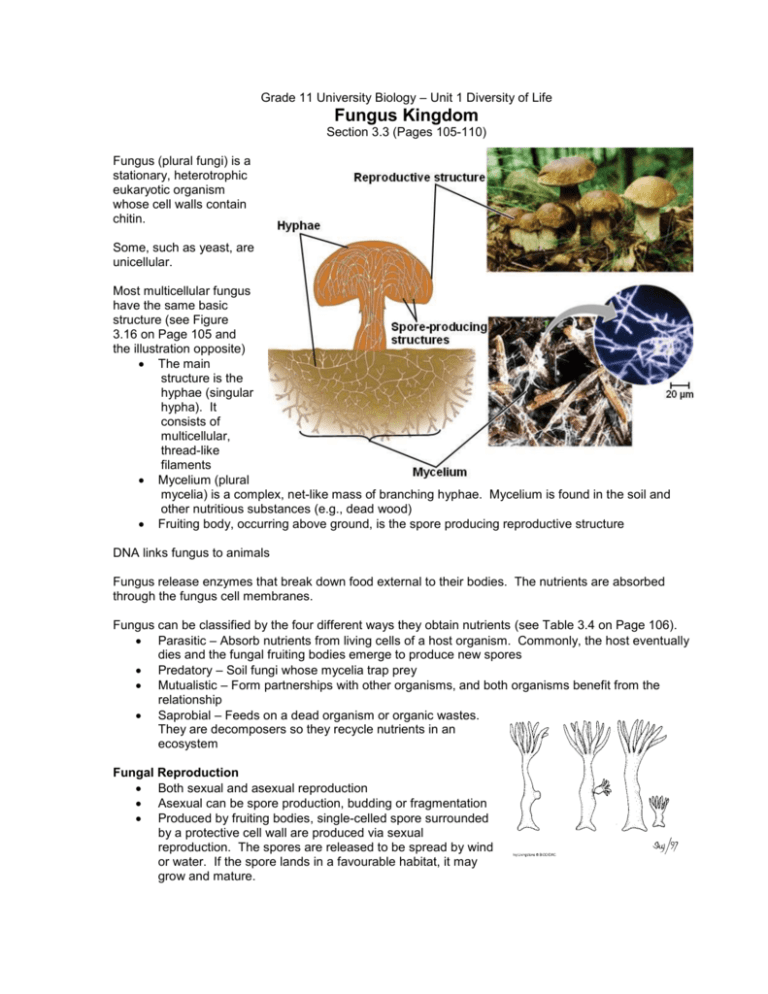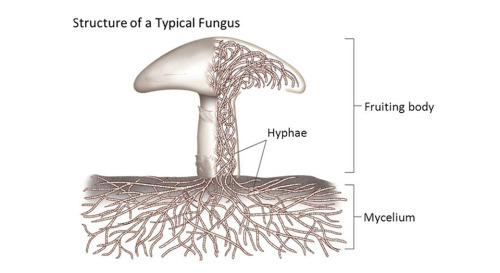Describe How Fungi Use Hyphae to Obtain Food
They then absorb the. Where do fungi digest their food.

Bio 101 Ch 30 Flashcards Quizlet
First the fungus grows hyphae into the food source.

. They grow from a tip. Describe a typical fruiting body of sac fungi bread mold and club fungi. What we see as mold on a piece of fruit or bread is actually the mycelium of the fungus that has colonized the food.
This way the mycorrhiza allows the plant to enjoy more water and nutrients than what they could have reached without any help. Most fungi are made up of a network of threads called hyphae. They release enzymes and absorb nutrients from a food source.
The system of hyphae produced by an individual fungus may be extensive with the hyphae accumulating in thick mats. As fungi grow hyphae extend into the food source and release enzymes that break down their food so it can be absorbed through cell walls. During asexual reproduction some hyphae become spore-producing bodies called sporangia or conidia.
They obtain nutrition by absorption of food from their environment. Multicellular fungi are made of hyphae. How does fungi obtain food.
Fungi are of high medicinal nutritive and environmental significance. The latter are called mycelia singular mycelium. Some are employed in a wide array of industrial functions like yeast in bread-making and as model organisms in scientific research.
Sporangia can be unicellular or multicellular and look like a sac or a capsule. Hyphae absorb nutrients from the environment. Septa are important as they allow cellular organelles eg ribosomes to pass between cells via large pores.
Describe how fungi use hyphae to obtain their food. Sporangia are formed during the life cycle of a typical bread mold. Instead they use saprotrophic nutrition.
According to the Journal of Wild Mushrooming hyphae are threadlike branching structures that make up the body of the fungus. Describe how slime molds help other organisms within an ecosystem obtain nutrients. Hyphae have a firm cell wall made of chitin.
The snares are used to trap tiny nematodes. Fungi obtain food molecules through a process called absorption 2. They secrete enzymes onto their food so that digestion happens outside the fungal cells.
Fungi obtains its food by having hyphae that absorb nutrients in one spot then the hyphae grow out to absorb more nutrients. Hyphae are the feathery filaments that make up multicellular fungi. They cannot make their own food and must obtain nutrients from organic material.
Food in the form of liquid can only enter into hyphae the entire mycelial surface of Fungus has the capability to absorb water and minerals entered through hyphae. Describe a typical fruiting body of sac fungi bread mold and club fungi. These are hyphae of a Penicillium fungus.
Fungi that decompose dead or decaying materials use their hyphae to colonize the food source such as the plant material. The digestive enzyme helps to break down the food and the root-like substance present of the Fungi called hyphal walls absorbs the food. The enzymes digest the food which then is absorbed directly through the hyphal walls.
Fungi are eukaryotic organisms that can be single-celled yeasts or multicellular molds. Together this structure is called a mycelium. Digestion precedes ingestion.
At what stage are they formed. Fungi dont photosynthesize so they must acquire their food in the following ways. Fungi cannot carry out photosynthesis.
Firstly the hyphae penetrate the food substance and then produce enzymes. The mycelium can extend into surfaces as the. Finally the chemicals break down food into small subsistences that can be absorbed by the hyphae.
This is how Fungi obtain their food. When they find adequate moisture and food fungi make spores asexually. Fungi obtain food by absorbing food through their hyphae Describe how fungi reproduce asexually.
At the right the Fan-shaped Jelly Fungus Dacryopinax spathularia grows from a split in a decaying tree stem. Draw a flowchart showing the sequence of steps in the reproduction of yeast a single celled fungus. The absorb the nutrients from the environment.
Bread mold uses sporangium which releases spore Sac fungi. A funguss network of hyphae is called a mycelium. To do so they use their hyphae which elongate and branch off rapidly allowing the mycelium of the fungus to quickly increase in size.
Hyphae are long strands which may either consist of a long cell having many nuclei or a chain of monokaryotic. The hyphae of the fungi tend to travel even further that the roots of the plant can reach. Each hypha is comprised of at least one cell encapsulated by a protective cell wall typically made of chitin and contain internal septa which serve to divide the cells.
Fungi secure food through the action of enzymes biological catalysts secreted into the surface on which they are growing. How do fungi use hyphae to obtain their food. The mycelium is considered the thallus or body of the fungus.
As fungi grow hyphae extend into the food source and. The large surface area of the hypha increases its ability to secrete digestive enzymes 3. Then the smaller molecules produced by the external digestion are absorbed through the large surface areas of the mycelium.
Saprophytes obtain their nutrients directly from dead organic matter or wastes. This sac or capsule then bursts to release the spores. The group of fungi known as Zygomycota develop sporangia within a sac.
Microbe World describes one species of fungus called Arthrobotrys dactyloides that actually creates snares to capture prey by forming looped hyphae. First exoenzymes enzymes that catalyze reactions on compounds outside of the cell are transported out of the hyphae where they break down nutrients in the environment. The funguss hyphae creating a cobwebby network inside the stem.
Describe how fungi use hyphae to obtain their food. How do fungi use hyphae to obtain their food. Fungi like animals do not carry out photosynthesis.
As fungi grow hyphae extend into the food source and release enzymes that break down their food so it can be absorbed through cell walls. Hyphae absorb nutrients from the environment. Then digestive chemicals ooze from the hyphae into the food.
The large surface area of the hypha increases its ability to absorb the breakdown products of digestion 4. However not all species of fungi contain septa. Hyphae absorb nutrients from the environment.
Their cell wall is composed of chitin which is a polysaccharide.

Hyphae Definition Function And Structure Biology Dictionary

Multicellular Fungus Hyphae Ppt Download

Fungal Cell Structure Fungi Hyphae With Septa Septum Vacuole Nucleus Vector Diagram For Educational Biological And Science Use Royalty Free Cliparts Vectors And Stock Illustration Image 142474445

Fungi Overview And Structure Study Guide Inspirit

Biology Ii Week 8 Flashcards Quizlet

Hyphae Overview Function Types What Is Hyphae In Fungi Video Lesson Transcript Study Com

Fungi Microbiology Health And Disease

Hyphae Mycelium High Resolution Stock Photography And Images Alamy
6 L 5a 2 How Fungi Respond To External Stimuli South Carolina 6th Grade Science
Difference Between Mycelia And Hyphae Difference Between

1 Describe How Fungi Use Hyphae To Obtain

19 5 Diversity Of Fungi Words To Know Chitin Hyphae Mycelium Fruiting Body Sporangia Ppt Download







Comments
Post a Comment